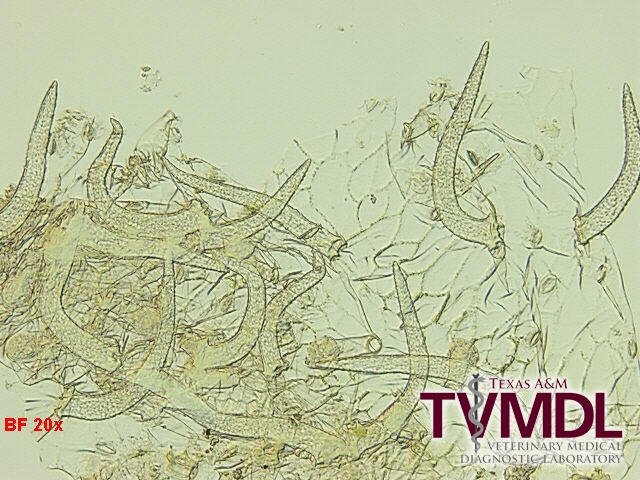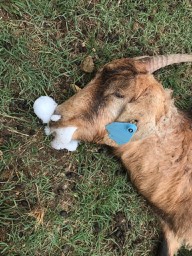Multiple goats diagnosed with senna plant toxicosis
By Cat Barr, PhD, DABT, Erin Edwards, DVM, MS, DACVP, Barbara Lewis, DVM, MS, DACVP, and Travis Mays, MS
In late March of this year, the Texas A&M Veterinary Medical Diagnostic Laboratory (TVMDL) diagnosed senna toxicosis in two separate goat herds, from west and central Texas.
In the first case, a 2-month-old goat kid was found suddenly dead along with one other goat kid. A third surviving kid was reported to be clinically ill. Histologically, the heart was the primarily affected organ and lesions where characterized by mild to moderate necrosis, degeneration, and regeneration of cardiomyocytes. Microscopic analysis of submitted rumen contents performed in the toxicology laboratory section identified plant fragments of twinleaf senna (Fig. 1).
In the second case, seven yearling Spanish goats developed a vague illness of several days duration then died suddenly with copious amounts of blood-tinged foam exuding from the mouth and nose (Fig. 2). Tissues from two of the goats were submitted to TVMDL for histopathologic examination. The major lesions were in the heart and consisted of mild to marked, acute cardiomyofiber degeneration and necrosis with dystrophic mineralization. There was variable pulmonary edema and congestion and centrilobular hepatocellular degeneration. The clinical history, gross and histologic findings were indicative of cardiotoxicity. Rumen contents from one of the affected goats was submitted and examined by the toxicology section, and fragments of twinleaf senna were identified.
There are many species of the senna family. Some more common examples of toxic senna plants include twinleaf senna (Senna roemeriana), coffee senna (Senna occidentalis), sicklepod (Senna obtusifolia), and Lindheimer senna (Senna lindheimeriana). Twinleaf senna grows on calcareous soils, mostly west of I-35 through New Mexico, but also in South Texas. Coffee senna is found in East and South Texas and extends all the way to Florida and up to Virginia. Sicklepod grows all along the Gulf Coast, through the eastern third of Texas and northward up to Indiana, while Lindheimer’s senna inhabits shallow limestone soils from the Edwards Plateau westward through Arizona and southward into Mexico.
All parts of a senna plant are toxic, although the relative toxicity of foliage and seed varies somewhat from species to species. All species except twinleaf are relatively unpalatable when green and are more often eaten once dry for the winter. Senna plants are toxic to all species tested, with an unidentified toxin that causes disruption of mitochondrial power gradients in myocytes. In cattle, the large muscle groups are the most severely affected. Poisoned cattle are down, but alert and responsive, though unable to rise. They will eat and drink if material is provided and often have coffee-colored urine (thus the name, coffee senna). Once so profoundly affected, cattle do not recover. In goats and chickens, the cardiac muscle is primarily affected. The animals may suddenly die of heart failure soon after consuming the senna plant material or may recover from the initial insult and die suddenly upon exerting themselves. In horses, both muscle and liver damage are produced.
Because twinleaf senna is quite palatable, the potential to have poisonings all summer where it is available is likely. For the other three sennas, use the butter-yellow blooms to locate them during the summer if they are on your property, so that you can keep animals clear of those areas this winter and avoid exposures.
To learn more about this case, contact Dr. Cat Barr, veterinary toxicology, Dr. Erin Edwards, veterinary pathologist, Dr. Barb Lewis, veterinary pathologist, or Analytical Chemistry Section Head Travis Mays. For more information about

